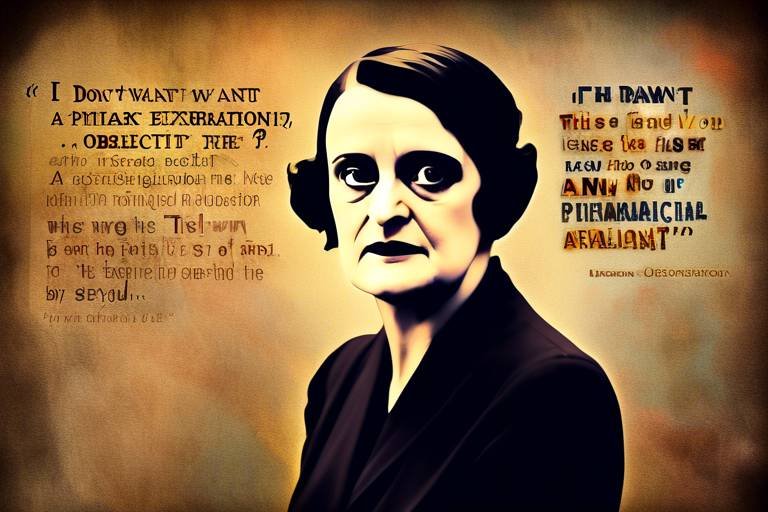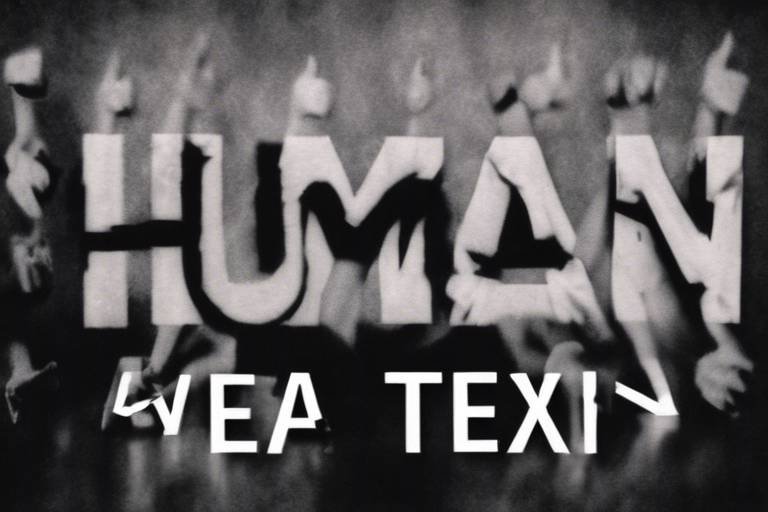The Philosophy of Modern Day Feminism
Modern day feminism is a vibrant tapestry woven from the experiences, struggles, and triumphs of women across the globe. It's not just a movement; it's a philosophy that seeks to challenge societal norms and advocate for gender equality. Feminism today is a response to the multifaceted issues that women face, from workplace discrimination to reproductive rights, and it encompasses a diverse range of voices and perspectives. The evolution of feminism has been marked by significant milestones, but its core principles remain focused on creating a world where women can thrive without the shackles of inequality.
At its heart, modern feminism is about empowerment. It's about giving women the tools and the agency to make choices about their own lives. But empowerment isn't just a buzzword; it's a movement that emphasizes the importance of self-determination. Imagine a world where every woman has the freedom to pursue her dreams, unencumbered by societal expectations or limitations. This is the vision that modern feminism strives to achieve.
Furthermore, the philosophy of modern feminism is not monolithic. It embraces a variety of perspectives, acknowledging that women's experiences are shaped by various intersecting factors such as race, class, and sexuality. This recognition of diversity is crucial; it ensures that feminism is inclusive and representative of all women's voices. After all, how can we advocate for equality if we overlook the unique challenges faced by women from different backgrounds?
In contemporary society, feminism manifests in numerous ways. From grassroots activism to digital campaigns, the movement has adapted to the changing landscape of communication and social engagement. Women are using their voices on social media platforms to raise awareness about issues that matter to them, creating a ripple effect of change that transcends borders. This digital feminism is empowering a new generation of activists who are unafraid to challenge the status quo.
However, the journey toward equality is fraught with challenges. Modern feminism faces backlash from various quarters, as anti-feminist sentiments resurge in some societies. This backlash can be disheartening, but it also serves as a reminder of the work that still needs to be done. The feminist movement must confront these challenges head-on, promoting understanding and dispelling myths about what feminism truly stands for.
Ultimately, the philosophy of modern feminism is about creating a world where women are not only seen and heard but also valued and respected. It's about building bridges across divides and fostering collaboration among diverse groups. As we continue to navigate the complexities of modern life, the principles of feminism remain as relevant as ever, guiding us toward a more just and equitable society.
- What is modern feminism?
Modern feminism is a movement advocating for gender equality, focusing on empowering women and addressing various social issues affecting them.
- How does intersectionality play a role in feminism?
Intersectionality recognizes that women's experiences are shaped by overlapping social identities, such as race and class, and emphasizes the need for inclusive feminist discourse.
- What are some contemporary feminist movements?
Contemporary feminist movements address issues like reproductive rights, workplace equality, and gender-based violence, reflecting the ongoing relevance of feminism today.
- What challenges does modern feminism face?
Modern feminism encounters backlash, misrepresentation, and internal divisions, which must be addressed to effectively advance the movement.

The Historical Roots of Feminism
The roots of feminism stretch back centuries, deeply intertwined with the social, political, and economic fabric of society. It’s fascinating to think about how far we’ve come, isn’t it? The journey began in the late 19th and early 20th centuries, primarily with the suffragist movements, where women rallied for their right to vote. This was a pivotal moment that laid the groundwork for future feminist advocacy. Imagine a world where women were denied a voice in the democratic process—this was the reality, and it sparked a fire that continues to burn today.
As we delve deeper into the historical context of feminism, we can identify several key waves that have shaped its evolution:
| Wave | Time Period | Main Focus |
|---|---|---|
| First Wave | Late 19th - Early 20th Century | Suffrage and legal rights |
| Second Wave | 1960s - 1980s | Workplace equality and reproductive rights |
| Third Wave | 1990s - Early 2000s | Diversity and individuality |
| Fourth Wave | 2010s - Present | Digital activism and intersectionality |
The First Wave of feminism primarily focused on legal inequalities, particularly the right to vote. Women like Susan B. Anthony and Elizabeth Cady Stanton became household names, advocating tirelessly for their rights. Their efforts culminated in the 19th Amendment to the U.S. Constitution, granting women the right to vote in 1920. This victory was monumental, yet it was just the beginning.
Fast forward to the Second Wave, which emerged in the 1960s. This era expanded the feminist agenda to include issues such as workplace equality, reproductive rights, and sexual liberation. Figures like Betty Friedan and Gloria Steinem became influential voices, challenging societal norms and pushing for comprehensive changes. Can you imagine the courage it took to stand up against the status quo? It was a time of awakening, where women began to assert their rights in all aspects of life, from the workplace to the home.
The Third Wave of feminism, which began in the 1990s, brought a fresh perspective to the movement. This wave emphasized diversity and individuality, recognizing that women's experiences are not monolithic. Women of different races, sexual orientations, and socioeconomic backgrounds began to find their voices within the feminist discourse. This shift was crucial, as it acknowledged that feminism must be inclusive to be effective.
Today, we are witnessing the Fourth Wave of feminism, characterized by the rise of digital activism. Social media platforms have become powerful tools for mobilization, allowing women to share their stories and advocate for change on a global scale. Movements like #MeToo and #TimesUp have highlighted issues of sexual harassment and assault, sparking conversations that were once taboo. It’s remarkable how technology has reshaped the landscape of feminism, don’t you think?
In conclusion, understanding the historical roots of feminism is essential for grasping its modern interpretations. The struggles and triumphs of those who came before us continue to inspire and shape the movement today. As we reflect on this journey, it's clear that feminism is not just a fight for women; it’s a quest for equality that benefits all of society.
- What is feminism? Feminism is a social and political movement advocating for the rights and equality of women.
- What are the different waves of feminism? The different waves include the First Wave (suffrage), Second Wave (workplace equality), Third Wave (diversity), and Fourth Wave (digital activism).
- Why is intersectionality important in feminism? Intersectionality acknowledges that women’s experiences differ based on race, class, and other identities, promoting a more inclusive approach to gender equality.

Key Philosophical Concepts
Modern feminism is not just a single movement; it embodies a rich tapestry of philosophical ideas that have evolved over time. These concepts are crucial for understanding the goals and challenges that feminists face today. At the heart of modern feminism lies the idea of intersectionality, which examines how various social identities—such as race, class, and gender—interact to shape individual experiences. This approach encourages a more nuanced understanding of the struggles women face, acknowledging that not all women experience oppression in the same way. For instance, a white woman may encounter different societal barriers compared to a woman of color, which highlights the necessity of inclusive feminist discourse.
Another foundational concept is empowerment. This idea revolves around the belief that women should have the power to make their own choices regarding their lives, careers, and bodies. Empowerment is about giving women the tools they need to take control of their destinies. However, empowerment alone isn’t enough; it must be coupled with autonomy. Autonomy emphasizes the importance of self-determination, suggesting that true equality can only be achieved when women are free to make decisions without external coercion or societal pressure.
To further illustrate these concepts, consider the following table that outlines the key philosophical ideas within modern feminism:
| Concept | Description |
|---|---|
| Intersectionality | Explores how overlapping identities impact women's experiences, advocating for an inclusive approach to feminism. |
| Empowerment | Focuses on enabling women to make choices about their lives and futures. |
| Autonomy | Stresses the importance of self-determination in achieving true equality. |
Understanding these concepts is essential for anyone looking to engage with modern feminist thought. They not only provide a framework for analyzing gender issues but also serve as a call to action for individuals and communities alike. Feminism today is more than just a fight for women's rights; it's a movement that seeks to dismantle systemic inequalities and promote a more just world for everyone. The interplay between these philosophical ideas creates a dynamic landscape that is constantly evolving, reflecting the diverse experiences and voices within the feminist movement.
- What is intersectionality? Intersectionality is a framework that examines how different social identities intersect and impact an individual's experience of oppression or privilege.
- Why is empowerment important in feminism? Empowerment is crucial because it enables women to take control of their lives and make informed decisions, leading to greater equality.
- How does autonomy relate to feminism? Autonomy emphasizes the need for women to have the freedom to make their own choices, which is essential for achieving true equality.

Intersectionality in Feminism
Intersectionality is a term that has become a cornerstone of modern feminist discourse, and for good reason. It was coined by legal scholar Kimberlé Crenshaw in the late 1980s to illustrate how various forms of discrimination—such as racism, sexism, and classism—interact and overlap, creating unique experiences for individuals based on their multiple identities. Think of it like a Venn diagram where different circles represent different aspects of identity. The intersections of these circles show us where people experience compounded discrimination. This approach is crucial for understanding that feminism cannot be one-size-fits-all; it must consider the diverse realities that women face.
In today's society, the need for intersectionality in feminism is more pressing than ever. Women do not exist in a vacuum; their experiences are shaped by their race, class, sexual orientation, disability, and other social identities. For instance, a white, middle-class woman may face challenges related to gender, but those challenges can be vastly different from those experienced by a Black, working-class woman. The latter may grapple with systemic racism in addition to sexism, creating a complex landscape of oppression that requires a nuanced understanding.
To illustrate this point further, consider the following table that outlines some of the key aspects of intersectionality in feminism:
| Identity Aspect | Challenges Faced | Feminist Response |
|---|---|---|
| Race | Systemic racism, cultural stereotypes | Inclusive policies and representation |
| Class | Economic disparity, access to education | Advocacy for economic equality |
| Sexual Orientation | Homophobia, lack of representation | Support for LGBTQ+ rights |
| Disability | Inaccessibility, social stigma | Focus on accessibility and inclusion |
It's essential to recognize that intersectionality is not just a theoretical framework; it has real-world implications. For example, when discussing issues like reproductive rights, a feminist perspective that lacks an intersectional lens may overlook how women of color or low-income women face additional barriers to accessing healthcare. This means that advocacy must be tailored to address these specific challenges rather than adopting a blanket approach.
Moreover, intersectionality encourages a broader coalition among feminists. It fosters solidarity by reminding us that our struggles are interconnected. When we champion the rights of marginalized groups, we enrich the feminist movement as a whole. This inclusivity not only strengthens our advocacy but also ensures that no one is left behind in the quest for equality.
In conclusion, intersectionality is vital for a comprehensive understanding of feminism today. It challenges us to look beyond our own experiences and consider the myriad ways in which identity shapes the lives of women. By embracing this complexity, we can create a more inclusive and effective feminist movement that truly represents all voices. So, the next time you engage in feminist discourse, ask yourself: are we considering the full spectrum of women's experiences?
- What is intersectionality in feminism? Intersectionality is a framework that examines how various social identities overlap and contribute to unique experiences of discrimination and privilege.
- Why is intersectionality important? It is crucial for understanding the diverse experiences of women and ensuring that feminism addresses the needs of all groups, particularly those who are marginalized.
- How can I support intersectional feminism? Educate yourself on the issues faced by different groups, listen to diverse voices, and advocate for policies that promote inclusivity and equality.

Race and Feminism
When we delve into the intersection of , we're not just looking at a simple overlap; we're examining a complex tapestry woven from the threads of different identities and experiences. Women of color have long faced unique challenges that often go unrecognized within mainstream feminist discourse. This lack of recognition can lead to feelings of alienation among those who are already marginalized. It's crucial to understand that feminism cannot claim to be truly inclusive unless it actively addresses the specific issues that women of color encounter.
For instance, while many feminist movements have focused on issues like reproductive rights and workplace equality, the experiences of women of color often encompass additional layers of struggle. Women from diverse racial backgrounds may find themselves grappling with systemic racism, economic disparities, and cultural biases that further complicate their fight for gender equality. This is where the concept of intersectionality becomes essential, as it encourages a more nuanced understanding of how various forms of discrimination intersect and impact individuals differently.
To illustrate, consider the following table that highlights some of the unique challenges faced by women of color in the context of feminism:
| Challenge | Description |
|---|---|
| Systemic Racism | Women of color often face institutional barriers that limit their access to opportunities and resources. |
| Economic Disparities | Women of color are more likely to experience wage gaps and job instability compared to their white counterparts. |
| Cultural Stereotypes | Negative stereotypes can lead to discrimination in both personal and professional settings, affecting self-esteem and opportunities. |
Moreover, the feminist movement must also confront its own history of exclusion. Historically, many feminist leaders were white women who prioritized issues that resonated primarily within their communities. This has led to a perception that feminism is often a privileged movement, one that does not fully advocate for the rights of all women. Acknowledging this past is a vital step towards building a more inclusive future.
In order to foster a truly inclusive feminist movement, it's essential for feminists of all backgrounds to engage in open dialogue about these issues. By actively listening to the voices of women of color and amplifying their stories, the movement can evolve into a more comprehensive and representative force for change. This means not only advocating for gender equality but also addressing the underlying racial injustices that intersect with gender.
In conclusion, the relationship between race and feminism is a critical aspect of the broader feminist movement. By recognizing and addressing the unique challenges faced by women of color, we can work towards a more inclusive and equitable society. This journey requires commitment, empathy, and a willingness to learn from one another, ultimately leading to a stronger feminist movement that champions the rights of all women.
- What is intersectionality in feminism? Intersectionality is a framework that examines how different social identities, such as race, gender, and class, overlap and impact individuals' experiences of oppression and privilege.
- How does race impact women's experiences in feminism? Women of color often face additional challenges, such as systemic racism and economic disparities, which are not always addressed in mainstream feminist movements.
- Why is it important to include diverse voices in feminism? Including diverse voices ensures that the feminist movement is truly representative and addresses the unique challenges faced by all women, not just a select few.

Class and Feminism
When we dive into the intricate relationship between class and feminism, it becomes clear that the dynamics of socioeconomic status play a pivotal role in shaping women's experiences and challenges. Feminism, at its core, aims to dismantle the barriers that hinder women from achieving equality, but how can it effectively do this without addressing the class disparities that exist within society? It's like trying to bake a cake without flour; you might have the icing and decorations, but the foundation is missing.
Consider this: women from affluent backgrounds may have access to resources, education, and opportunities that empower them to pursue their goals. In contrast, women from lower socioeconomic classes often face an uphill battle. They might struggle with basic needs, such as housing, healthcare, and education, which can significantly impact their ability to engage in feminist activism or advocate for their rights. The intersection of class with gender creates a complex web of challenges that cannot be overlooked.
To illustrate this further, let's look at a few key factors that demonstrate how class influences feminist discourse:
- Access to Education: Women from lower-income families may not have the same educational opportunities as their wealthier counterparts, limiting their career prospects and independence.
- Workplace Inequality: Women in lower-paying jobs often face more significant challenges, such as wage gaps, lack of benefits, and job security, which are compounded by their class status.
- Health Disparities: Access to healthcare can vary dramatically based on class, affecting women's overall well-being and their ability to make informed choices about their bodies.
Thus, it becomes essential for modern feminism to adopt a more inclusive approach that recognizes and addresses these class-based disparities. By doing so, the movement can create a more equitable platform for all women, regardless of their economic background. This inclusivity is not just a moral imperative; it is a strategic necessity for the feminist movement to gain traction and foster genuine change.
Moreover, the dialogue around class and feminism also encourages solidarity among women from different backgrounds. When women unite, sharing their stories and experiences, they can amplify their voices and advocate for systemic changes that benefit everyone. This sense of community can be incredibly powerful, as it fosters understanding and empathy, bridging the gaps created by socioeconomic divides.
In conclusion, class and feminism are inextricably linked. To achieve true gender equality, it is vital to acknowledge and address the challenges that women face due to their socioeconomic status. Only then can feminism evolve into a more comprehensive movement that uplifts all women, ensuring that no one is left behind.

Empowerment and Autonomy
When we talk about empowerment and autonomy in the context of modern feminism, we're diving deep into the heart of what it means to be a woman in today's world. Empowerment is all about giving women the tools, resources, and confidence they need to take control of their own lives. It’s like handing someone the keys to their own car; suddenly, they can drive wherever they want, not just where someone else tells them to go. This concept is crucial because without empowerment, women often find themselves stuck in roles defined by others, limiting their potential and opportunities.
On the flip side, autonomy is about self-determination. It’s the idea that women should have the right to make choices about their own bodies, careers, and lives without interference. Imagine being the captain of your own ship, navigating through the tumultuous waters of life. Autonomy means you decide the course, not someone else. This is especially important when we consider issues like reproductive rights, where the ability to make decisions about one’s own body is paramount.
However, achieving true empowerment and autonomy isn't as simple as it sounds. There are numerous barriers that women face, including societal norms, economic disparities, and systemic inequalities. For instance, a woman may feel empowered in her career but still struggle with autonomy if she faces discrimination or harassment in the workplace. This intersection of empowerment and autonomy is where feminism plays a vital role, advocating for policies and practices that support women's rights and freedoms.
To illustrate the relationship between empowerment and autonomy, consider the following table:
| Aspect | Empowerment | Autonomy |
|---|---|---|
| Definition | Gaining power and confidence to make choices | Having the freedom to make personal decisions |
| Focus | Access to resources and opportunities | Self-determination and personal agency |
| Challenges | Societal expectations, economic barriers | Legal restrictions, cultural norms |
As we move forward, it’s essential to recognize that empowerment and autonomy are not just buzzwords; they are fundamental rights that every woman should possess. Feminism seeks to create a world where these concepts are not just ideals but realities. This means advocating for educational opportunities, equal pay, and the right to make choices about one’s own body. When women are empowered and autonomous, they can contribute to society in ways that benefit everyone, creating a ripple effect that positively impacts families, communities, and even economies.
In conclusion, the journey toward empowerment and autonomy is ongoing, but with the collective efforts of the feminist movement, we can continue to break down the barriers that hold women back. By fostering an environment where women can thrive, we pave the way for a more equitable and just society. So, let's keep the conversation going and ensure that every woman has the opportunity to drive her own ship!
- What is the difference between empowerment and autonomy?
Empowerment refers to gaining the confidence and tools to make choices, while autonomy is about having the freedom to make those choices without interference. - Why is empowerment important in feminism?
Empowerment is crucial because it allows women to take control of their lives and pursue their goals, leading to greater equality and societal change. - How can we promote autonomy for women?
Promoting autonomy involves advocating for policies that protect women's rights, providing education, and challenging societal norms that limit women's choices.

Contemporary Feminist Movements
Modern feminism is a vibrant tapestry of movements that address a multitude of issues affecting women today. It's not just a single narrative; rather, it’s a collection of voices and experiences that come together to advocate for gender equality across various spheres of life. From reproductive rights to workplace equality, contemporary feminist movements are crucial in shaping policies and social attitudes. They challenge the status quo and push for systemic changes that benefit not only women but society as a whole.
One of the most significant aspects of contemporary feminism is its ability to adapt to changing societal norms and technological advancements. For instance, the rise of digital platforms has opened new avenues for activism, allowing feminists to reach wider audiences and engage younger generations. Social media has become a powerful tool for mobilization, providing a space for discussions that might not have been possible before. Hashtags like #MeToo and #TimesUp have sparked global conversations about sexual harassment and workplace inequality, highlighting the urgent need for change.
Moreover, contemporary feminism is not confined to one geographical location; it has a global dimension. Global feminism recognizes the diverse experiences of women from different cultures and backgrounds. It advocates for solidarity among women worldwide, emphasizing that issues like gender-based violence, reproductive rights, and economic inequality are not isolated problems but are interconnected. For example, women in developing countries face unique challenges that may differ from those in Western societies, yet their struggles are equally valid and deserving of attention.
In addition to addressing global issues, contemporary feminist movements also focus on intersectionality. This concept is vital in understanding how various social identities—such as race, class, and sexuality—intersect to create unique experiences of oppression and privilege. By embracing intersectionality, modern feminism seeks to create a more inclusive movement that advocates for all women, especially those who have historically been marginalized. It’s about acknowledging that not all women face the same challenges and that solutions must be tailored to address these differences.
While contemporary feminist movements have made significant strides, they also face challenges that threaten their progress. Issues such as backlash against feminist ideals, misrepresentation in media, and internal divisions can hinder the effectiveness of these movements. It’s essential for feminists to engage in open dialogue and collaboration, ensuring that a variety of voices are heard and respected. By doing so, they can work towards a more unified front that can effectively advocate for change.
In summary, contemporary feminist movements are dynamic and multifaceted, reflecting the complexities of modern society. They are characterized by their adaptability, inclusivity, and commitment to addressing a wide range of issues that impact women globally. As we continue to navigate the challenges and triumphs of feminism today, it’s clear that the fight for gender equality is far from over, but with collective effort, progress is achievable.
- What is the main goal of contemporary feminism?
Contemporary feminism aims to achieve gender equality by addressing a wide range of issues, including reproductive rights, workplace equality, and gender-based violence. - How has social media impacted feminist movements?
Social media has transformed feminist activism by providing platforms for discussion, mobilization, and raising awareness, allowing movements to reach broader audiences. - What does intersectionality mean in feminism?
Intersectionality refers to the way different social identities, such as race, class, and gender, intersect to create unique experiences of oppression and privilege, emphasizing the need for an inclusive feminist discourse. - Are contemporary feminist movements global?
Yes, contemporary feminist movements recognize the diverse experiences of women worldwide and advocate for solidarity in addressing universal gender issues.

Global Feminism
Global feminism is a powerful movement that transcends borders, cultures, and languages, uniting women from all walks of life in the pursuit of equality and justice. This concept recognizes that while women share common struggles, their experiences are shaped by a myriad of factors, including geography, culture, and socio-economic status. It's like a beautiful tapestry, where each thread represents a unique story, yet all contribute to the larger picture of women's rights globally.
One of the most significant aspects of global feminism is its emphasis on solidarity. Women around the world face different challenges, from reproductive rights to access to education, and the movement seeks to create a unified front that advocates for all. For instance, while a woman in the United States may be fighting for equal pay in the workplace, a woman in Afghanistan might be battling for basic education rights. Both struggles are vital, and global feminism aims to elevate these voices, ensuring that no woman is left behind.
Moreover, global feminism fosters collaboration among various feminist movements worldwide. This collaboration can take on many forms, such as sharing resources, strategies, and successes. A notable example is the partnership between local grassroots organizations and international NGOs, which can amplify the impact of their work. By pooling knowledge and experiences, these groups can address issues more effectively and create a ripple effect of change that resonates across different regions.
However, global feminism also faces its own set of challenges. One major hurdle is the risk of imposing Western ideals onto non-Western cultures. It's crucial to approach feminism with cultural sensitivity, recognizing that what works in one context may not be applicable in another. This is where the principle of intersectionality becomes essential, as it helps to highlight the diverse experiences of women and the multiple layers of oppression they may face.
To illustrate the importance of global feminism, consider the following table that outlines some key issues faced by women in different regions:
| Region | Key Issues |
|---|---|
| Africa | Gender-based violence, access to education, and healthcare |
| Middle East | Legal restrictions, lack of representation, and cultural norms |
| Asia | Child marriage, trafficking, and workplace discrimination |
| North America | Workplace equality, reproductive rights, and sexual harassment |
In conclusion, global feminism is not just a movement; it’s a call to action for women everywhere to stand together and fight for their rights. It is a reminder that while our paths may differ, our destination is the same: a world where every woman can live freely and with dignity. As we continue to advocate for gender equality, let us remember the importance of listening to and amplifying the voices of women from all backgrounds, because together, we are stronger.
- What is global feminism? Global feminism is a movement that seeks to unite women across the world to fight for gender equality and justice, acknowledging the diverse experiences of women based on their cultural and socio-economic backgrounds.
- How does global feminism differ from local feminism? While local feminism focuses on specific issues within a particular community or country, global feminism addresses issues that affect women worldwide and promotes solidarity among various feminist movements.
- What challenges does global feminism face? Global feminism faces challenges such as cultural sensitivity, the risk of imposing Western ideals, and the need for intersectionality to ensure all women's voices are heard.

Digital Feminism
In the age of technology, has emerged as a powerful force, reshaping the landscape of feminist activism. The internet, particularly social media platforms, has become a vibrant space where ideas can flourish, movements can gain momentum, and voices that were once silenced can now be heard. It's like a digital revolution, where hashtags and tweets can spark global conversations and mobilize communities in ways that were unimaginable just a few decades ago.
One of the most significant aspects of digital feminism is its ability to connect individuals across geographical and cultural boundaries. For instance, the #MeToo movement, which gained traction on platforms like Twitter and Facebook, highlighted the pervasive issue of sexual harassment and assault. It showed how a simple hashtag could unite women (and men) from all walks of life, sharing their stories and experiences. This sense of solidarity is crucial; it reminds us that while our experiences may differ, the fight for equality is a shared endeavor.
Moreover, digital feminism leverages the power of visual storytelling. Platforms like Instagram and TikTok allow activists to express their messages creatively, using images, videos, and memes to engage a younger audience. This visual language can be incredibly impactful. Just think about how a single image can evoke emotions and provoke thought in ways that words alone sometimes cannot. For example, campaigns that use striking visuals to convey messages about body positivity or reproductive rights can resonate deeply and inspire action.
However, with great power comes great responsibility. Digital spaces can also amplify negative sentiments and misinformation. The rise of anti-feminist rhetoric online poses a challenge that the movement must confront. Activists are not only fighting for women's rights but also against a tide of backlash that seeks to undermine their progress. This requires a strategic approach to counteract misinformation and promote a more nuanced understanding of feminism. Engaging in constructive dialogue, fact-checking claims, and fostering an inclusive environment online are essential steps in this ongoing battle.
In addition, the digital realm has given rise to new forms of activism, such as online petitions, crowdfunding campaigns, and virtual events. These tools allow individuals to contribute to causes they care about without geographical limitations. For example, platforms like Change.org enable users to start petitions that can garner thousands of signatures in a matter of days, amplifying their voices and demanding change from those in power. This democratization of activism means that anyone with internet access can participate, making the feminist movement more accessible than ever.
As we navigate this digital landscape, it's essential to recognize that digital feminism is not a replacement for traditional activism. Instead, it complements and enhances it. Grassroots movements still play a vital role, and the energy generated online can translate into real-world action. For instance, online campaigns can lead to protests, community organizing, and policy changes. The synergy between digital and physical activism can create a powerful force for change.
In conclusion, digital feminism represents a new frontier in the fight for gender equality. It harnesses the power of technology to amplify voices, connect individuals, and mobilize movements. As we continue to explore this evolving landscape, it's crucial to remain vigilant against the challenges it presents while embracing the opportunities it offers. The future of feminism is undoubtedly digital, and it's up to us to shape it into a force for good.
- What is digital feminism? Digital feminism refers to the use of digital platforms, particularly social media, to advocate for gender equality and women's rights.
- How has social media impacted feminist movements? Social media has allowed feminist movements to gain visibility, connect individuals globally, and mobilize support for various causes.
- What are some challenges of digital feminism? Challenges include the spread of misinformation, backlash against feminist ideas, and maintaining constructive dialogue in online spaces.
- Can digital activism lead to real-world change? Yes, online campaigns can inspire protests, community organizing, and influence policy changes, bridging the gap between digital and traditional activism.

Challenges Facing Modern Feminism
Despite the strides made in the feminist movement, modern feminism faces a myriad of challenges that threaten its progress and unity. One of the most significant hurdles is the backlash against feminism, which has seen a resurgence of anti-feminist sentiments in various forms. This backlash often manifests itself through social media campaigns, political rhetoric, and even legislative measures aimed at undermining the rights that women have fought so hard to secure. The spread of misinformation can easily sway public opinion, creating an environment where the goals of feminism are misrepresented and ridiculed. For instance, phrases like "feminism is man-hating" or "feminists want to take away your rights" are common misconceptions that can derail constructive discourse.
Moreover, the internal divisions within the feminist movement can also pose significant challenges. With so many diverse voices and perspectives, disagreements about priorities and strategies are inevitable. Some feminists may prioritize issues like reproductive rights, while others might focus on workplace equality or combating gender-based violence. This divergence can lead to a fragmented movement, where instead of uniting for a common cause, different factions may inadvertently undermine each other's efforts. It’s crucial for the feminist community to engage in open dialogue, fostering an environment of collaboration rather than contention. After all, the strength of feminism lies in its diversity. A united front can be more effective in addressing the systemic issues that women face today.
Another challenge is the misrepresentation of feminist ideals in popular culture and media. Often, feminism is simplified into a one-dimensional narrative that fails to capture its complexities. This oversimplification can lead to a skewed understanding of feminism among the general public, making it easier for critics to dismiss it as irrelevant or outdated. To combat this, it's essential for feminists to actively share their stories and experiences, showcasing the multifaceted nature of the movement. By doing so, they can help reshape the narrative and highlight the ongoing relevance of feminism in today's society.
In addition, the intersectionality of feminism presents both opportunities and challenges. While the inclusion of diverse perspectives is vital, it can also lead to tension when different groups feel that their specific issues are not being adequately addressed. For example, women of color, LGBTQ+ individuals, and those from various socioeconomic backgrounds each face unique challenges that may not always align with mainstream feminist agendas. Thus, it’s imperative for the feminist movement to prioritize inclusivity, ensuring that all voices are heard and valued. This can be achieved through community-building efforts, educational initiatives, and collaborative projects that emphasize solidarity among different groups.
Lastly, the global landscape of feminism introduces additional complexities. While many feminists in Western countries may focus on issues like reproductive rights and workplace equality, women in other parts of the world may be grappling with issues such as violence, poverty, and lack of access to education. This disparity can create a disconnect, leading to a perception that feminism is a Western-centric movement. It’s essential for feminists everywhere to recognize and advocate for the unique challenges faced by women globally, fostering a sense of solidarity that transcends borders.
- What is modern feminism? Modern feminism is a diverse movement that advocates for gender equality and addresses the unique challenges faced by women today.
- Why is intersectionality important in feminism? Intersectionality is crucial because it acknowledges how overlapping social identities, such as race and class, shape women's experiences and challenges.
- What are some common challenges facing modern feminists? Common challenges include backlash against feminist ideals, internal divisions within the movement, misrepresentation in media, and the need for global solidarity.
- How can feminists combat misinformation? Feminists can combat misinformation by actively sharing their stories, engaging in constructive dialogues, and promoting accurate representations of feminist ideals.

Backlash Against Feminism
The journey of feminism has never been a smooth one. Just as a river encounters rocks and bends in its path, feminism faces significant backlash that threatens to undermine its progress. In recent years, we have witnessed a resurgence of anti-feminist sentiments that echo past struggles, manifesting in various forms—be it through social media campaigns, political rhetoric, or cultural narratives. This backlash can often feel like a storm cloud overshadowing the bright ideals of equality and justice that feminism strives for.
One of the most alarming aspects of this backlash is the spread of misinformation. With the rise of digital platforms, false narratives about feminism have proliferated, painting it as a movement that seeks to elevate women at the expense of men. This misrepresentation not only fuels animosity but also distorts the core message of feminism: the pursuit of equality for all genders. It’s crucial to understand that feminism is not about diminishing men’s rights; rather, it’s about creating a level playing field where everyone can thrive.
Moreover, the backlash often manifests as a cultural phenomenon, where feminist ideals are ridiculed in popular media. Movies, television shows, and even news outlets sometimes portray feminists as angry or extreme, which can alienate potential allies. This portrayal can lead to a perception that feminism is out of touch with mainstream values, creating a divide between the movement and the general public. When people see feminism through a distorted lens, they may hesitate to engage with its principles, fearing social backlash themselves.
To combat this, it’s essential for feminists to actively engage in conversations that clarify misconceptions. Education is a powerful tool; by sharing factual information about the movement’s goals and achievements, feminists can dismantle the barriers created by misinformation. Additionally, using inclusive language that resonates with diverse audiences can help bridge the gap between feminists and those who may feel alienated by the movement.
Another significant challenge posed by the backlash is the internal divisions within the feminist movement itself. Different factions often disagree on priorities and strategies, which can lead to a fragmented approach in addressing issues. This disunity can be exploited by anti-feminist groups who thrive on the narrative that feminists cannot even agree among themselves. To counteract this, it’s vital for feminists to engage in open dialogue, embracing the diversity of thought within the movement while focusing on common goals. Only through collaboration can feminism present a united front against the backlash it faces.
In summary, the backlash against feminism is a multifaceted issue that requires a strategic response. By addressing misinformation, promoting inclusive dialogue, and fostering unity within the movement, feminists can work to counteract the negative narratives that threaten to undermine their progress. Just like a phoenix rising from the ashes, feminism can emerge stronger and more resilient, continuing its fight for equality in the face of adversity.
- What is the main goal of feminism? Feminism aims to achieve equality between genders, advocating for women's rights and addressing issues such as discrimination, violence, and reproductive rights.
- Why is there backlash against feminism? Backlash stems from misunderstandings about the movement, cultural portrayals, and internal divisions, often fueled by misinformation.
- How can feminists combat misinformation? Engaging in education, using inclusive language, and fostering open dialogue can help clarify misconceptions and promote understanding.
- What role does unity play in feminism? Unity is essential for presenting a strong front against backlash and ensuring that diverse voices within the movement work together towards common goals.

Internal Divisions
Within the feminist movement, often arise, creating a complex landscape that can hinder progress and dilute the overall mission. These divisions stem from a variety of factors, including differing priorities, cultural backgrounds, and ideologies. For instance, while some feminists may prioritize issues like reproductive rights, others might focus on workplace equality or combating gender-based violence. This divergence in focus can lead to misunderstandings and even conflict, as various factions vie for attention and resources.
Moreover, the intersectionality of feminism adds another layer of complexity. Women from different racial, economic, and social backgrounds can have vastly different experiences, which can sometimes lead to feelings of exclusion or misrepresentation within the movement. For example, a white feminist might advocate for policies that benefit her community but inadvertently overlook the unique challenges faced by women of color or those from lower socioeconomic backgrounds. This lack of inclusivity can create a rift, making it essential for the movement to engage in ongoing dialogue and collaboration.
To illustrate these internal divisions, consider the following table that outlines some of the key areas of disagreement:
| Area of Disagreement | Description |
|---|---|
| Reproductive Rights | Some feminists focus heavily on access to abortion and contraception, viewing these as fundamental rights. |
| Workplace Equality | Others emphasize equal pay and representation in leadership roles as primary goals. |
| Intersectionality | Debates often arise about how to prioritize issues affecting marginalized groups within the feminist framework. |
These divisions can sometimes lead to a perception that feminism is fragmented or ineffective. However, it’s crucial to recognize that these discussions are a natural part of any evolving movement. The key is to foster an environment where diverse voices can be heard and respected, allowing for a richer, more nuanced understanding of gender equality. By embracing these differences, modern feminism can work towards creating a more inclusive platform that addresses the needs of all women.
- What are the main internal divisions within feminism? The main divisions often revolve around differing priorities such as reproductive rights, workplace equality, and intersectionality.
- How does intersectionality affect feminist movements? Intersectionality highlights the unique challenges faced by women of different races and classes, emphasizing the need for inclusive discussions.
- Why is open dialogue important in feminism? Open dialogue fosters understanding and collaboration, allowing the movement to address diverse issues and perspectives effectively.
Frequently Asked Questions
- What is the core philosophy of modern feminism?
Modern feminism is rooted in the pursuit of gender equality and encompasses various principles such as empowerment, autonomy, and intersectionality. It aims to address the unique challenges faced by women in today's society while advocating for their rights and opportunities.
- How did feminism evolve from its historical roots?
The evolution of feminism can be traced from early suffragist movements that fought for women's voting rights to contemporary advocacy for broader issues like reproductive rights and workplace equality. Understanding this historical context is crucial for grasping the complexities of modern feminist thought.
- What is intersectionality and why is it important?
Intersectionality is a key concept in modern feminism that examines how overlapping social identities—such as race, class, and gender—affect women's experiences. It emphasizes the need for an inclusive feminist discourse that recognizes and addresses the diverse challenges faced by women from different backgrounds.
- What challenges do women of color face in feminism?
Women of color often encounter unique obstacles that intersect with both race and gender, such as systemic racism and economic disparities. Feminism seeks to amplify their voices and advocate for a more comprehensive approach to achieving gender equality.
- How does class impact feminist theory?
Class dynamics significantly influence feminist theory, as socioeconomic status can dictate access to resources, education, and opportunities. Feminism aims to address these disparities to create a more equitable society for all women, regardless of their class background.
- What does empowerment mean in the context of feminism?
Empowerment in feminism refers to enabling women to make informed choices about their lives and assert their rights. It emphasizes the importance of self-determination and agency as essential components of achieving true gender equality.
- What are some contemporary feminist movements?
Modern feminism manifests through various movements that tackle issues like reproductive rights, workplace equality, and gender-based violence. These movements reflect the ongoing relevance and adaptability of feminism in addressing current societal challenges.
- What is global feminism?
Global feminism recognizes the diverse experiences of women around the world and advocates for solidarity in addressing universal gender issues. It emphasizes the importance of cooperation among women from different cultures and backgrounds to create meaningful change.
- How has social media impacted feminist activism?
Social media has transformed feminist activism by providing new platforms for expression and mobilization. It allows younger generations to engage with feminist issues, share their experiences, and organize movements more effectively than ever before.
- What challenges does modern feminism face today?
Modern feminism is confronted with a range of challenges, including backlash against feminist ideals, misrepresentation in media, and internal divisions within the movement. Addressing these obstacles is crucial for advancing the goals of feminism and ensuring its continued relevance.
- What is the backlash against feminism?
The backlash against feminism refers to the resurgence of anti-feminist sentiments that challenge the progress made in gender equality. This backlash can manifest in various forms, including misinformation and societal pushback against feminist initiatives, requiring strategic responses to counteract its effects.
- How can internal divisions within feminism be addressed?
Internal divisions within feminism can hinder progress, but they can be addressed through open dialogue and collaboration among diverse voices. Encouraging respectful discussions about differing priorities and strategies can help unify the movement and strengthen its impact.



















